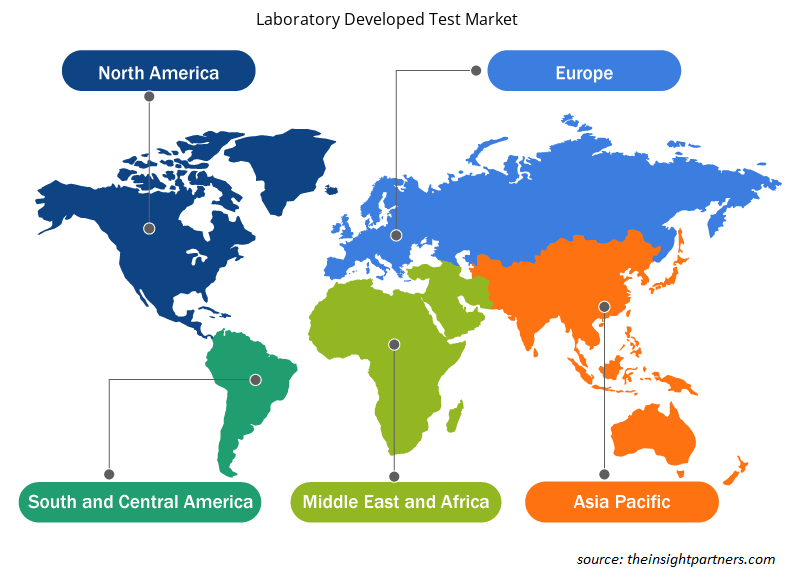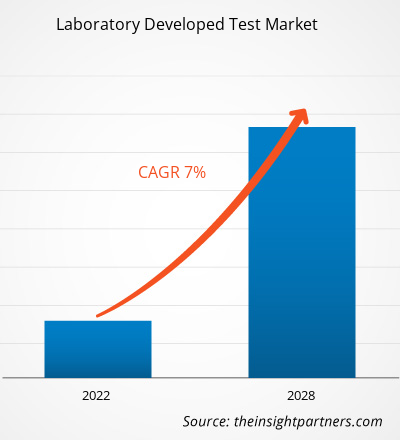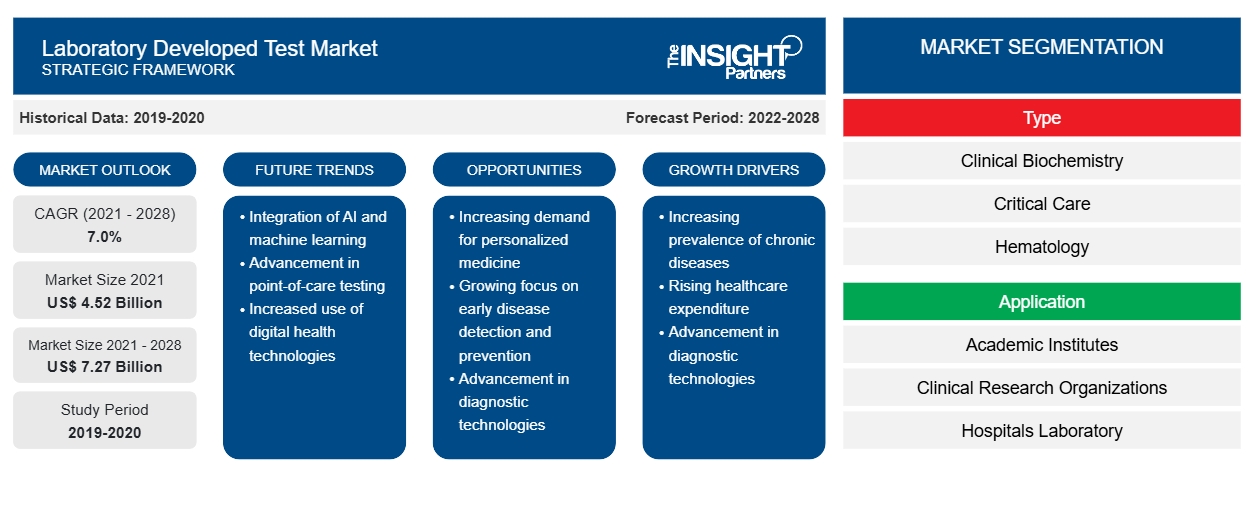من المتوقع أن يصل سوق الاختبارات المعملية إلى 7،269.3 مليون دولار أمريكي بحلول عام 2028 من 4،524.75 مليون دولار أمريكي في عام 2021؛ ومن المتوقع أن ينمو بمعدل نمو سنوي مركب قدره 7.0٪ خلال الفترة 2021-2028.
الاختبار المطوَّر في المختبر (LDT) هو نوع من اختبارات التشخيص المختبرية المصممة والمستخدمة داخل مختبر واحد. يمكن استخدام هذه الاختبارات لتقدير أو تمييز المحللات مثل البروتينات والجزيئات الحيوية/المركبات (الجلوكوز والكوليسترول وما إلى ذلك) والحمض النووي المستخرج من العينات التي تم جمعها من البشر. إن التوسع في طرق التشخيص المختبري الآلي (IVD) للمختبرات والصيدليات لتقديم تحليل دقيق وخالٍ من الأخطاء يغذي نمو سوق الاختبارات المختبرية.
يعود نمو سوق الاختبارات المعملية بشكل أساسي إلى عوامل مثل زيادة حالات الإصابة بالسرطان والاضطرابات الوراثية، والعدد الكبير من إطلاقات المنتجات. ومع ذلك، فإن المشهد التنظيمي المتغير يعيق نمو السوق. على سبيل المثال، في أوروبا، سيكون الامتثال للوائح الأجهزة المختبرية إلزاميًا لجميع اختبارات التشخيص المختبرية اعتبارًا من مايو 2022؛ تهدف اللائحة إلى تأمين الفعالية السريرية وسلامة الاختبارات الطبية، وبالتالي تحويل صناعة التشخيص، وهو ما يشكل مصدر قلق كبير للاعبين في السوق.
قم بتخصيص هذا التقرير ليناسب متطلباتك
ستحصل على تخصيص لأي تقرير - مجانًا - بما في ذلك أجزاء من هذا التقرير، أو تحليل على مستوى الدولة، وحزمة بيانات Excel، بالإضافة إلى الاستفادة من العروض والخصومات الرائعة للشركات الناشئة والجامعات
-
احصل على أهم اتجاهات السوق الرئيسية لهذا التقرير.ستتضمن هذه العينة المجانية تحليلاً للبيانات، بدءًا من اتجاهات السوق وحتى التقديرات والتوقعات.
رؤى السوق
البحث المستمر في الأدوية المخصصة يوفر فرص النمو للاعبين في سوق الاختبارات التي تم تطويرها في المختبرات
تلعب الاختبارات المعملية دوراً حيوياً في تطوير الأدوية المخصصة التي من المرجح أن تثبت أنها وسيلة واعدة لمعالجة الأمراض من خلال علاجات أو شفاءات فعّالة بعيدة المنال. ووفقاً لتحالف الأدوية المخصصة، شكلت الأدوية المخصصة 5% فقط من الكيانات الجزيئية الجديدة المعتمدة من إدارة الغذاء والدواء في عام 2005؛ ومع ذلك، في عام 2016، ارتفع هذا الرقم إلى أكثر من 25%. بالإضافة إلى ذلك، فإن 42% من جميع المركبات و73% من مركبات الأورام في خط الأنابيب لديها القدرة على العمل كأدوية مخصصة. وقد ضاعفت شركات الأدوية الحيوية استثماراتها في البحث والتطوير في الأدوية المخصصة في السنوات الخمس الماضية، ومن المتوقع أن تزيد استثماراتها بنسبة 33% في السنوات الخمس المقبلة. ويتوقع الباحثون في مجال الأدوية الحيوية أيضاً زيادة بنسبة 69% في تطوير الأدوية المخصصة في السنوات الخمس المقبلة. تُستخدم الاختبارات المعملية لتشخيص المرض والتنبؤ باستجابة الدواء ومراقبتها فضلاً عن الحصول على البيانات المعلوماتية اللازمة لخوارزميات التنبؤ المعقدة. play a vital role in the development of personalized medicines that are likely to prove as promising means of tackling diseases through far eluded effective treatments or cures. As per the Personalized Medicine Coalition, personalized medicines accounted for only 5% of the new FDA-approved molecular entities in 2005; however, in 2016, this number rose to more than 25%. Additionally, 42% of all compounds and 73% of oncology compounds in the pipeline have the potential to serve as personalized medicines. Biopharmaceutical companies have nearly doubled their R&D investments in personalized drugs in the last five years, and they are further expected to increase their investments by 33% in the next five years. Biopharmaceutical researchers also predict a 69% increase in the development of personalized medicines in the next five years. Laboratory tests are used to diagnose illness and predict and monitor drug response as well as to obtain informatics data needed for complex predictive algorithms.
أصبحت الأدوية المخصصة هي العلامة التجارية لعلاج السرطان؛ فهي نهج يتطور باستمرار ويستند إلى تخصيص العلاجات وفقًا للتركيبة الجينية الفردية. في عام 2019، وافقت إدارة الغذاء والدواء على 12 دواءً مخصصًا للتحقيق في الأسباب الجذرية للمرض ومعالجتها، وبالتالي الجمع بين الطب الدقيق في الرعاية السريرية. يوفر الطلب المتزايد على الأدوية المخصصة فرص نمو كبيرة لنمو اللاعبين العاملين في سوق الاختبارات التي تم تطويرها في المختبر.
رؤى مبنية على النوع
ينقسم سوق الاختبارات المعملية، حسب النوع، إلى الكيمياء الحيوية السريرية، والرعاية الحرجة، وأمراض الدم، وعلم الأحياء الدقيقة، والتشخيص الجزيئي، وعلم المناعة، وغيرها. ومن المتوقع أن يستحوذ قطاع التشخيص الجزيئي على أكبر حصة من السوق في عام 2021. ومع ذلك، من المتوقع أن يسجل قطاع أمراض الدم أعلى معدل نمو سنوي مركب في السوق خلال الفترة المتوقعة.CAGR in the market during the forecast period.
رؤى قائمة على التطبيق
من حيث التطبيق، تم تطوير تطبيق سوق الاختبارات المعملية في المعاهد الأكاديمية ومنظمات البحوث السريرية ومختبرات المستشفيات ومراكز التشخيص المتخصصة وغيرها. ومن المتوقع أن يشكل قطاع مختبرات المستشفيات أكبر حصة سوقية في عام 2021. ومع ذلك، من المتوقع أن يسجل قطاع مراكز التشخيص المتخصصة أعلى معدل نمو سنوي مركب في السوق خلال فترة التوقعات.CAGR in the market during the forecast period.
إن إطلاق المنتجات والموافقة عليها هي عادة استراتيجيات تتبناها الشركات لتوسيع نطاق وجودها العالمي ومحافظ منتجاتها. وعلاوة على ذلك، يركز اللاعبون في سوق الاختبارات التي تم تطويرها في المختبرات على استراتيجية الشراكة لتوسيع قاعدة عملائهم، الأمر الذي يسمح لهم بدوره بالحفاظ على اسم علامتهم التجارية على مستوى العالم.
يقسم التقرير سوق الاختبارات المعملية المتطورة على النحو التالي
بناءً على النوع، يتم تقسيم سوق الاختبارات التي تم تطويرها في المختبر إلى الكيمياء الحيوية السريرية، والرعاية الحرجة، وأمراض الدم، وعلم الأحياء الدقيقة، والتشخيص الجزيئي، وعلم المناعة، وغيرها. بناءً على التطبيق، يتم تقسيم سوق الاختبارات التي تم تطويرها في المختبر إلى معاهد أكاديمية، ومنظمات أبحاث سريرية، ومختبرات مستشفيات، ومراكز تشخيص متخصصة، وغيرها. على أساس الجغرافيا، يتم تقسيم سوق الاختبارات التي تم تطويرها في المختبر إلى أمريكا الشمالية (الولايات المتحدة وكندا والمكسيك)، وأوروبا (المملكة المتحدة وألمانيا وفرنسا وإيطاليا وإسبانيا وبقية أوروبا)، وآسيا والمحيط الهادئ (الصين واليابان والهند وأستراليا وكوريا الجنوبية وبقية آسيا والمحيط الهادئ)، والشرق الأوسط وأفريقيا (الإمارات العربية المتحدة والمملكة العربية السعودية وجنوب أفريقيا وبقية الشرق الأوسط وأفريقيا)، وأمريكا الجنوبية والوسطى (البرازيل والأرجنتين وبقية أمريكا الجنوبية والوسطى).
رؤى إقليمية حول سوق الاختبارات المعملية
لقد قام المحللون في Insight Partners بشرح الاتجاهات والعوامل الإقليمية المؤثرة على سوق الاختبارات المعملية طوال فترة التوقعات بشكل شامل. يناقش هذا القسم أيضًا قطاعات سوق الاختبارات المعملية والجغرافيا في جميع أنحاء أمريكا الشمالية وأوروبا ومنطقة آسيا والمحيط الهادئ والشرق الأوسط وأفريقيا وأمريكا الجنوبية والوسطى.

- احصل على البيانات الإقليمية المحددة لسوق الاختبارات المعملية المطورة
نطاق تقرير سوق الاختبارات المعملية
| سمة التقرير | تفاصيل |
|---|---|
| حجم السوق في عام 2021 | 4.52 مليار دولار أمريكي |
| حجم السوق بحلول عام 2028 | 7.27 مليار دولار أمريكي |
| معدل النمو السنوي المركب العالمي (2021 - 2028) | 7.0% |
| البيانات التاريخية | 2019-2020 |
| فترة التنبؤ | 2022-2028 |
| القطاعات المغطاة |
حسب النوع
|
| المناطق والدول المغطاة |
أمريكا الشمالية
|
| قادة السوق وملفات تعريف الشركات الرئيسية |
|
كثافة اللاعبين في سوق الاختبارات التي تم تطويرها في المختبر: فهم تأثيرها على ديناميكيات الأعمال
يشهد سوق الاختبارات المعملية نموًا سريعًا، مدفوعًا بالطلب المتزايد من المستخدم النهائي بسبب عوامل مثل تفضيلات المستهلكين المتطورة والتقدم التكنولوجي والوعي المتزايد بفوائد المنتج. ومع ارتفاع الطلب، تعمل الشركات على توسيع عروضها والابتكار لتلبية احتياجات المستهلكين والاستفادة من الاتجاهات الناشئة، مما يؤدي إلى زيادة نمو السوق.
تشير كثافة اللاعبين في السوق إلى توزيع الشركات أو المؤسسات العاملة في سوق أو صناعة معينة. وهي تشير إلى عدد المنافسين (اللاعبين في السوق) الموجودين في مساحة سوق معينة نسبة إلى حجمها أو قيمتها السوقية الإجمالية.
الشركات الرئيسية العاملة في سوق الاختبارات المعملية المطورة هي:
- شركة كويست دياجنوستيكس
- شركة ف. هوفمان-لا روش المحدودة،
- كياجن
- شركة إيلومينا،
- يوروفينز العلمية
إخلاء المسؤولية : الشركات المذكورة أعلاه ليست مرتبة بأي ترتيب معين.

- احصل على نظرة عامة على أهم اللاعبين الرئيسيين في سوق الاختبارات المعملية
نبذة عن الشركة
- شركة كويست دياجنوستيكس
- شركة ف. هوفمان-لا روش المحدودة،
- كياجن
- شركة إيلومينا،
- يوروفينز العلمية
- بيوديسيكس
- التكنولوجيات الحيوية التكيفية
- العلاج الحيوي
- شركة روزيتا جينوميكس المحدودة،
- جاردانت هيلث
- التحليل التاريخي (سنتان)، سنة الأساس، التوقعات (7 سنوات) مع معدل النمو السنوي المركب
- تحليل PEST و SWOT
- حجم السوق والقيمة / الحجم - عالمي، إقليمي، بلد
- الصناعة والمنافسة
- مجموعة بيانات إكسل
التقارير الحديثة
شهادات العملاء
سبب الشراء
- اتخاذ قرارات مدروسة
- فهم ديناميكيات السوق
- تحليل المنافسة
- رؤى العملاء
- توقعات السوق
- تخفيف المخاطر
- التخطيط الاستراتيجي
- مبررات الاستثمار
- تحديد الأسواق الناشئة
- تحسين استراتيجيات التسويق
- تعزيز الكفاءة التشغيلية
- مواكبة التوجهات التنظيمية























 احصل على عينة مجانية ل - سوق الاختبارات المعملية المطورة
احصل على عينة مجانية ل - سوق الاختبارات المعملية المطورة